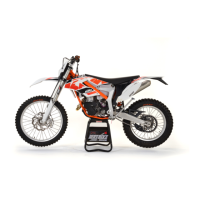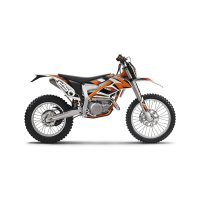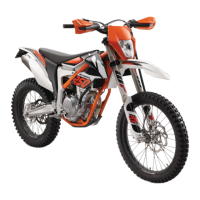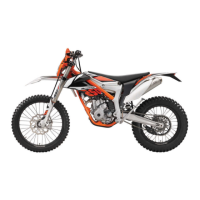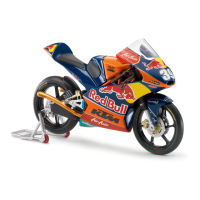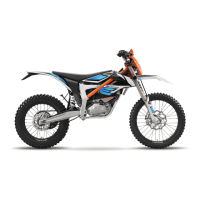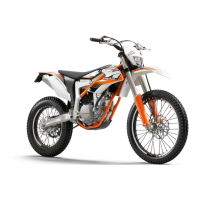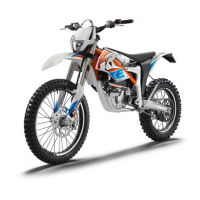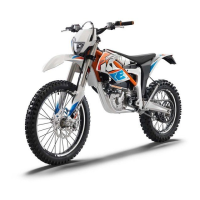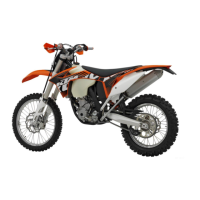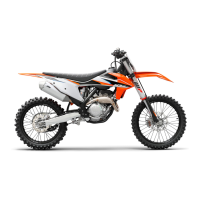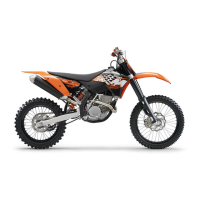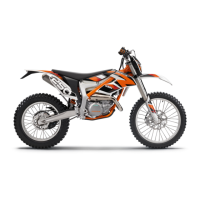
 Loading...
Loading...
Do you have a question about the KTM Freeride 250 R EU and is the answer not in the manual?
| Brand | KTM |
|---|---|
| Model | Freeride 250 R EU |
| Category | Motorcycle |
| Language | English |
Explanation of symbols indicating expected/unexpected reactions and required expertise.
Definitions for proprietary names, protected names, and open market brands.
Defines intended offroad use and general safety instructions for the motorcycle.
General safety instructions and importance of vehicle information/warning labels.
Identifies danger levels (Danger, Warning, Caution, Note) and associated symbols.
Details prohibited modifications to noise control systems and exhaust components.
Covers operating the vehicle safely, including avoiding impairment and hot components.
Emphasizes the necessity of wearing appropriate protective gear for rider safety.
Guidelines for performing work and responsible environmental practices.
Importance of reading and keeping the owner's manual accessible for safe operation.
Details warranty conditions, authorized workshops, and adherence to the service schedule.
Guidance on using correct fluids and environmental precautions for handling them.
Information on using approved parts and contacting customer service for support.
Diagram identifying key components from the front left side of the vehicle.
Labels for speedometer, levers, fuel tap, side stand, and steering lock.
Diagram identifying key controls and components from the rear right side.
Labels for kill switch, horn, light switch, starter button, and brake levers.
Instructions on finding the chassis number and the vehicle's type label.
Guidance on locating the key number and the engine serial number.
Instructions for finding part numbers stamped on the fork and shock absorber.
Details on operation of clutch lever, hand brake lever, and throttle grip.
Explanation of the kill switch function and how to use the horn button.
Operation of the light switch, turn signals, and electric starter buttons.
Details on the function and operation of the emergency OFF switch.
Explanation of high beam, FI warning, and low fuel warning indicator lights.
Instructions for safely opening and closing the fuel tank filler cap.
Description of the fuel tap positions (OFF, ON, RES) and their functions.
How to use the choke for cold starts and the operation of the shift lever.
Details on operating the foot brake lever and using the side stand.
How to lock and unlock the motorcycle's steering for security.
Step-by-step guide to locking the steering mechanism for parking.
Procedure for unlocking the steering mechanism to allow riding.
Identification of speedometer parts and how to activate the display.
Understanding display messages (service, battery) and initial setup.
How to select speed units (KM/H or M/H) and clock format (24h/12h).
Procedures for resetting time, adjusting service intervals, and switching off display.
Guide to changing the unit of measure for distance displayed on the speedometer.
Steps to set the 24-hour or 12-hour clock format and adjust time.
How to adjust, shorten, extend, or switch off the service interval reminder.
How to view speed, time, DST1, and DST2 trip meter readings.
Information on displaying AVG (average speed), ART (operating hours), and ODO (total distance).
Essential safety advice, protective clothing, and handling tips for new riders.
Checklist of controls, levers, and basic handling practice before riding.
Specifies maximum overall weight and axle load limits for safe operation.
Guidelines for running in the engine during the initial operating hours for longevity.
Comprehensive checklist of items to inspect before riding the motorcycle.
Safety precautions and steps for starting the engine, including cold start procedures.
How to start moving, shift gears smoothly, and handle inclines.
Techniques for applying front and rear brakes, avoiding wheel lock-up.
Guidelines for stopping the motorcycle, parking securely, and engine shutdown.
Recommendations for securing the motorcycle during transport to prevent damage.
Instructions for refueling, including fire hazards, fuel types, and tank capacity.
List of maintenance checks and tasks required at 50 operating hour intervals.
Tasks performed annually or at specific operating hour intervals (10, 50, 100 hours).
Adjusting suspension based on rider's weight for optimal riding characteristics.
Explanation of high-speed and low-speed compression damping for the shock absorber.
Procedure for adjusting the low-speed compression damping of the rear shock absorber.
Steps to adjust the high-speed compression damping on the rear shock absorber.
Procedure for adjusting the rebound damping on the rear shock absorber.
How to measure the rear wheel sag when the motorcycle is unloaded.
Procedure to check the static sag of the rear shock absorber.
How to measure the riding sag with the rider on the motorcycle.
Steps to adjust the spring preload on the rear shock absorber for rider weight.
Procedure for adjusting the riding sag, potentially involving spring changes.
Guidance on checking the fundamental settings of the front fork suspension.
How to adjust the compression damping on both front fork legs.
Procedure for adjusting the rebound damping on both front fork legs.
Adjusting handlebar support positions for rider comfort and control.
Step-by-step guide to repositioning the handlebar for optimal ergonomics.
Instructions for safely lifting and removing the motorcycle using a lift stand.
Procedure for bleeding excess pressure from the front fork legs.
How to clean dust boots to prevent dirt ingress and seal leakage.
Step-by-step guide for safely removing the front fork legs from the motorcycle.
Procedure for correctly installing the front fork legs, including tightening specs.
Steps to remove the protective covers from the front fork legs.
How to install the protective covers onto the front fork legs.
Procedure for removing the lower triple clamp assembly.
Steps for cleaning, greasing, and installing the lower triple clamp.
How to check for play in the steering head bearing for safe handling.
Procedure for adjusting play in the steering head bearing.
Instructions on how to grease the steering head bearing.
Steps for removing and installing the rear shock absorber.
Procedure for removing the front fender.
How to install the front fender, ensuring correct alignment.
Instructions for folding the seat up and securely locking it in place.
Steps to remove the air filter housing for access to the air filter.
Procedure for correctly mounting the air filter housing.
Steps for removing and installing the air filter element.
Detailed instructions for cleaning the air filter and its housing.
Procedure for removing the main exhaust silencer, including safety precautions.
How to mount and tighten the main exhaust silencer.
Procedure for replacing the glass fiber yarn filling in the main silencer.
Steps for safely removing the fuel tank, including fuel line disconnection.
Procedure for installing the fuel tank, ensuring correct routing of lines.
How to inspect the chain for dirt and determine if cleaning is needed.
Steps for cleaning and maintaining the drive chain for optimal life.
Procedure for checking the drive chain tension and wear.
How to adjust the chain tension correctly using the adjusters.
Inspection of chain, sprockets, and chain guide for wear and damage.
Procedure for inspecting the frame for cracks or deformation.
Inspection of the swingarm for damage, cracks, or deformation.
Verifying correct routing of the throttle cable to prevent snagging.
Inspection of handlebar rubber grips for damage, wear, or looseness.
Method for securing rubber grips using wire for added durability.
How to adjust the clutch lever position for rider comfort.
Procedure for checking the fluid level in the hydraulic clutch reservoir.
Steps to add fluid to the hydraulic clutch reservoir if needed.
Procedure for changing the hydraulic fluid in the clutch system.
Instructions for removing and installing the engine guard.
How to check and adjust the free travel of the front brake lever.
Procedure for inspecting brake discs for wear, damage, and cracking.
How to check the brake fluid level in the front reservoir.
Steps for adding front brake fluid, including safety precautions.
Procedure to check front brake lining thickness and condition.
Step-by-step guide for replacing the front brake linings.
How to check and adjust the free travel of the rear foot brake lever.
Procedure for adjusting the basic position of the foot brake lever.
How to check the brake fluid level in the rear brake reservoir.
Steps for adding rear brake fluid, including safety precautions.
Procedure to check rear brake lining thickness and condition.
Step-by-step guide for replacing the rear brake linings.
Steps for safely removing the front wheel, including axle and brake caliper.
Procedure for correctly installing the front wheel, including alignment.
Steps for safely removing the rear wheel, including axle and chain.
Procedure for correctly installing the rear wheel, chain, and axle.
Inspecting tires for cuts, debris, wear, and checking tread depth.
Correct tire air pressure settings for offroad and road use.
Procedure for checking and adjusting spoke tension for wheel integrity.
Safety precautions and steps for removing and installing the motorcycle battery.
Proper procedures for recharging the battery to maintain its service life.
Procedure for replacing the main fuse protecting the vehicle's electrical system.
How to replace fuses for individual components like horn, fan, and lights.
Steps for detaching the headlight mask and disconnecting wiring.
Procedure for reattaching the headlight mask and connecting wiring.
Guide to replacing the main headlight bulb and parking light bulb.
Procedure for replacing the turn signal bulb.
How to check headlight beam alignment against a wall.
How to adjust the headlight beam distance for proper illumination.
Procedure for replacing the battery in the speedometer unit.
Description of the cooling system, water pump, radiator cap, and fan.
Safety precautions and steps for checking coolant antifreeze and level.
Procedure for checking the coolant level in the radiator when the engine is cold.
Steps for safely draining the coolant from the system.
Procedure for refilling the cooling system with coolant and de-aerating.
How to check and adjust the play in the throttle cable.
Importance of correct idle setting for starting, idling, and throttle response.
Procedures for adjusting idle speed and mixture using carburetor screws.
Steps to drain fuel from the carburetor float chamber.
How to check and adjust the basic position of the shift lever.
Instructions for cleaning the alternator cover, rotor, and bendix.
Procedure for checking the gear oil level when the engine is cold.
Steps for draining and refilling the engine's gear oil.
Procedure for draining the gear oil, including safety and environmental precautions.
How to fill the engine with the correct type and amount of gear oil.
Procedure for adding gear oil if the level is low.
Detailed instructions for washing the motorcycle safely and effectively.
Specific checks and cleaning procedures for motorcycles used in winter conditions.
Steps for preparing the motorcycle for long-term storage, including fuel and battery care.
Checks and maintenance needed before riding the motorcycle after a storage period.
Diagnosing and resolving issues when the engine won't crank or start.
Troubleshooting causes for engine sputtering or backfiring through the carburetor.
Identifying reasons for engine overheating and corrective actions.
Diagnosing white smoke from exhaust and gear oil leaks.
Detailed technical specifications for the engine, including displacement and bore.
List of torque specifications for various engine fasteners and components.
Specifications for fluid capacities including gear oil, coolant, and fuel tank.
Details on frame type, fork, shock absorber, and suspension travel.
Specifications for battery, fuses, lights, and other electrical parts.
Information on front and rear tire sizes and types.
Details on fork part number, suspension travel, and damping adjustments.
Specifications for shock absorber, including damping, preload, and sag measurements.
Torque values for various chassis components like frame, triple clamp, and brakes.
Details on the carburetor model and identification number.
Settings for carburetor tuning, including idle air screw and jetting.
Recommended 2-stroke oil (JASO FC) and brake fluid (DOT 4/5.1).
Recommended coolant types and engine oil (15W/50) for the motorcycle.
Recommended cleaners for air filters and motorcycle chains.
Types of grease, fuel additives, and sprays recommended by KTM.
Explanation of JASO FC (2-stroke oil) and JASO T903 MA (4-stroke oil) standards.
Definition of SAE viscosity classes for oils and their meaning.
